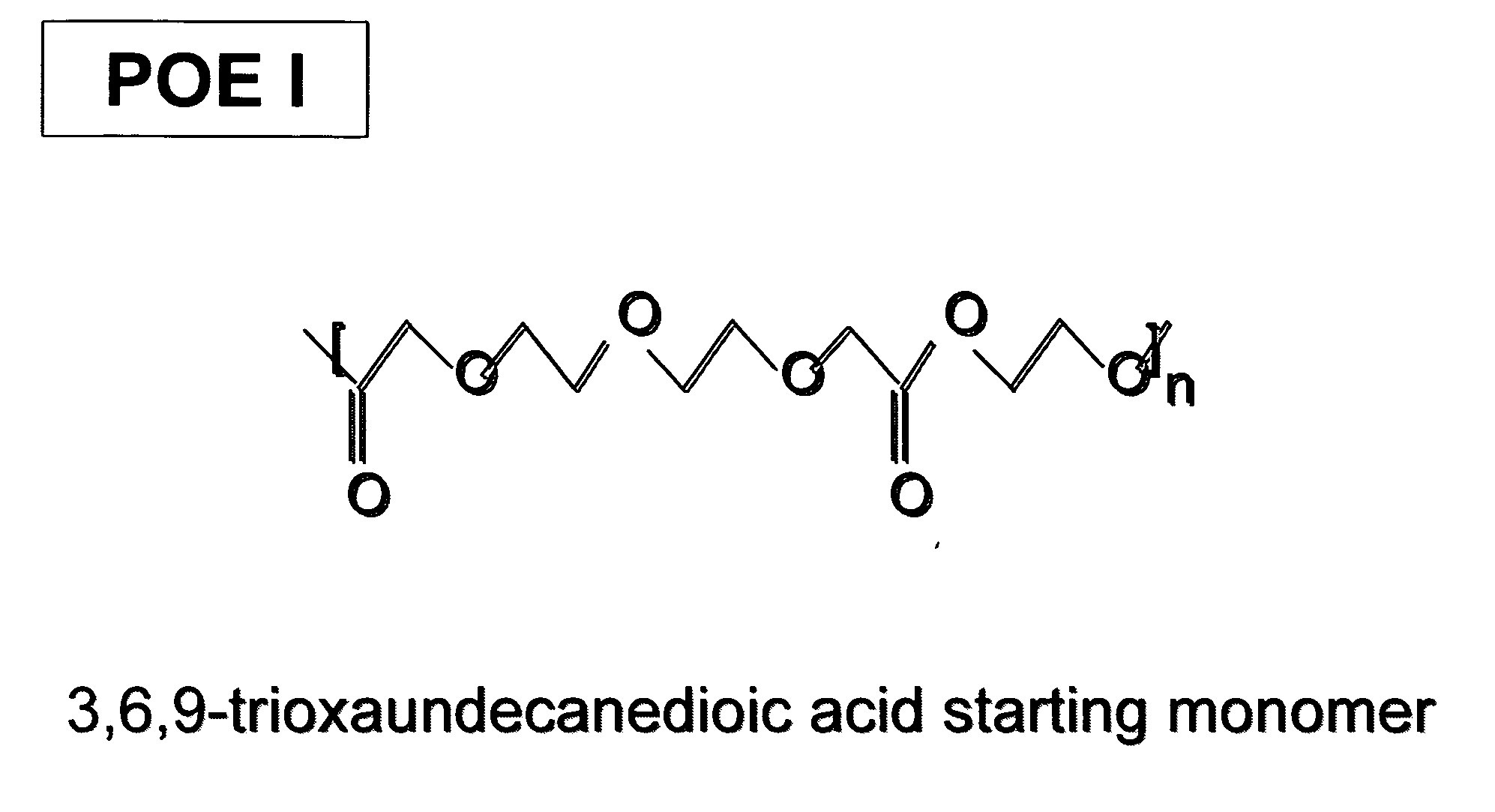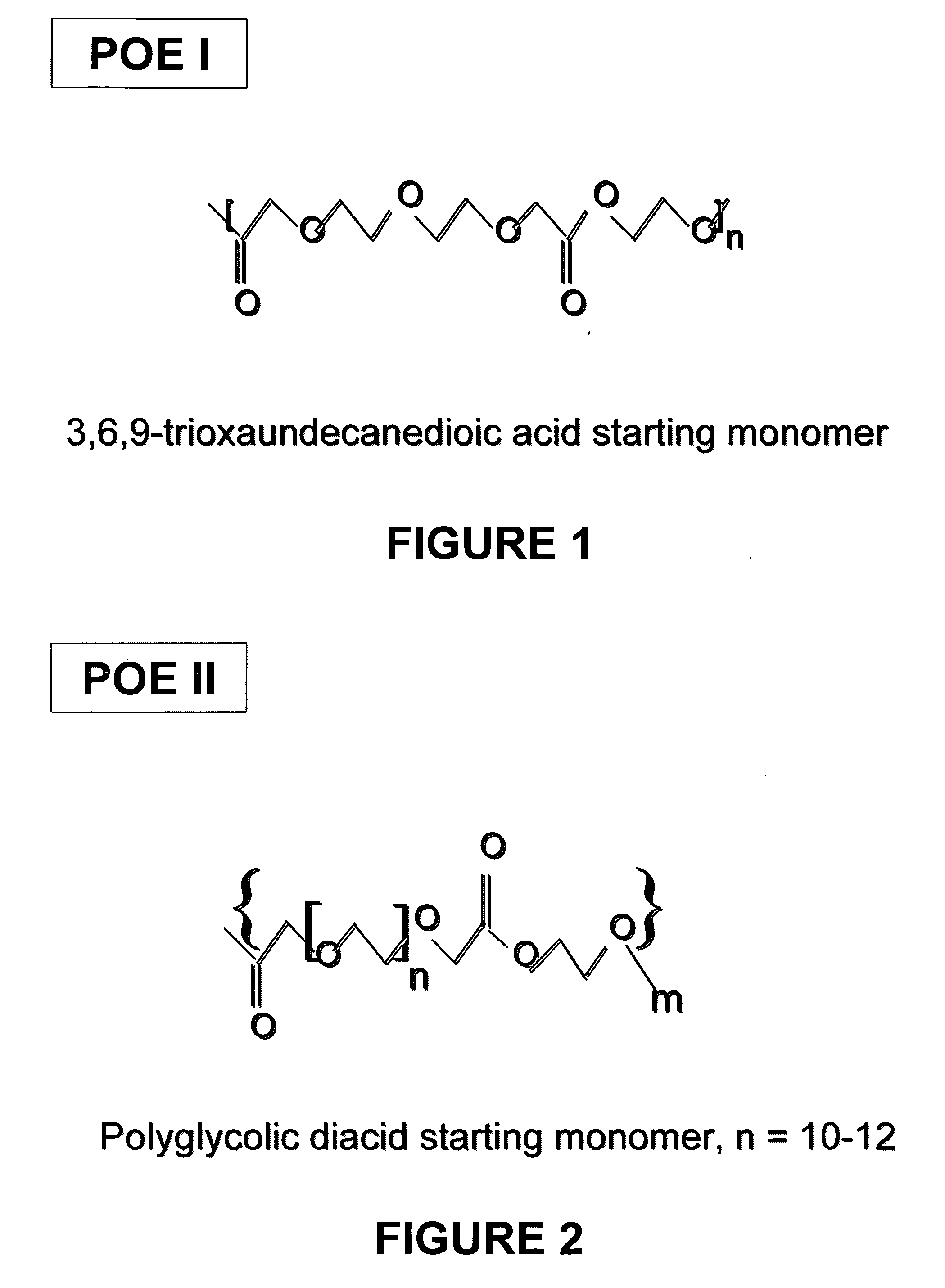Polyoxaester suspending vehicles for use with implantable delivery systems
a technology of suspension vehicle and polymer, which is applied in the direction of peptide/protein ingredients, powder delivery, dna/rna fragmentation, etc., can solve the problems of compromising the reliability of dosage forms, difficult to pump through narrow exit ports of suspension vehicles comprising polymers in conjunction with water-immiscible solvents, etc., to maintain drug stability and limit water ingress
- Summary
- Abstract
- Description
- Claims
- Application Information
AI Technical Summary
Benefits of technology
Problems solved by technology
Method used
Image
Examples
example 1
[0050] Several POE liquid polymers were prepared and physical properties were analyzed as shown in Table 1. The polymers were prepared generally by mixing the desired molar ratios of the diacid(s) and diol(s) monomers and a catalyst in a 2 neck, round bottom flask, under a nitrogen purge and heating the mixture to ˜160° C. slowly. The catalyst was dibutyltin oxide added at a ratio of 1 mole of catalyst to 30,000 mole monomer. Reactions typically started with a nominal molar ratio of approximately 1:2 diacid:diol, with the excess diol being removed under vacuum to result in a polymer that was approximately 1:1 diacid:diol.
[0051] The mixture was held at 160° C. for ˜24 hours. The temperature was then raised to 180° C. and held there for ˜24 hours. The mixture temperature was then reduced to 80° C. while vacuum was pulled slowly. Upon a vacuum of ˜50 mTorr, the temperature was increased to 160° C. for 2-3 days. Temperature was increased to 190° C. for a few hours until the sample beca...
example 2
[0056] POE I, a liquid polymer made from 3,6,9 trioxaundecanedioic acid and ethylene glycol, made in accordance with Example 1, was used as the suspending vehicle for a pharmaceutical suspension. The density of POE I was 1.29 g / mL+ / −0.010. The method for measuring density of the suspension vehicle included taking an aliquot (e.g. 10 μL) of the suspension vehicle (POE), which was accurately weighed (using a balance with an accuracy of ±0.01 mg). The value for the density of the sample was derived from the resultant weight over the volume of the sample taken (g / mL). The measurement was repeated three times and the average value of the three measurements and the standard deviation reported.
[0057] The inherent viscosity of POE I was 0.37 dL / g as determined in HFIP at 25° C. and at a concentration of 0.1 g / dL. Average moisture of the POE I samples was 0.19% and the average peroxide level was 8.21 ppm.
[0058] Lysozyme particles were prepared by spray-drying an aqueous lysozyme solution. ...
example 3
[0061] POE II, a liquid polymer made from polyglycolic diacid and ethylene glycol, having a viscosity of 100 poise (35° C.), made in accordance with Example 1, was used as the suspending vehicle for a pharmaceutical suspension. As shown in FIG. 3, there was no effect of shear rate on viscosity. FIG. 4 shows that no phase change occurred between 5° C. and 60° C., therefore, a phase change, if any, would occur at <5° C.
[0062] The density of the 100 poise (35° C.)-POE II was 1.18 g / mL+ / −0.006. The method for measuring the density was as described in Example 2. The inherent viscosity of 100 poise POE II was 0.30 dL / g as determined in HFIP at 25° C. and at a concentration of 0.1 g / dL.
[0063] Average moisture of the 100 poise POE II samples was 0.11% and the average peroxide level was 6.44 ppm.
[0064] Lysozyme particles are prepared by spray-drying an aqueous lysozyme solution. Lysozyme particles are collected and contained in lyophiliation vials in a low humidity environment. The 100 po...
PUM
| Property | Measurement | Unit |
|---|---|---|
| viscosity | aaaaa | aaaaa |
| temperature | aaaaa | aaaaa |
| viscosity | aaaaa | aaaaa |
Abstract
Description
Claims
Application Information
 Login to View More
Login to View More - R&D
- Intellectual Property
- Life Sciences
- Materials
- Tech Scout
- Unparalleled Data Quality
- Higher Quality Content
- 60% Fewer Hallucinations
Browse by: Latest US Patents, China's latest patents, Technical Efficacy Thesaurus, Application Domain, Technology Topic, Popular Technical Reports.
© 2025 PatSnap. All rights reserved.Legal|Privacy policy|Modern Slavery Act Transparency Statement|Sitemap|About US| Contact US: help@patsnap.com



